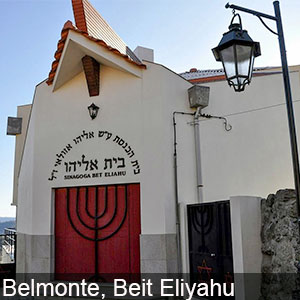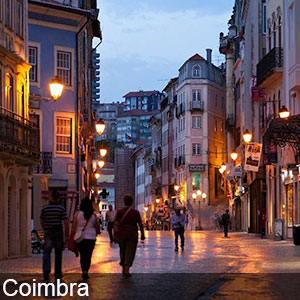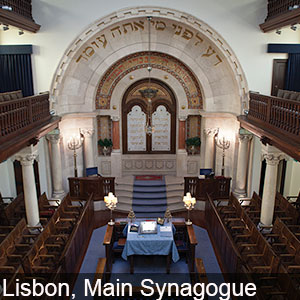
Jewish Heritage of Portugal
Overview / Highlights
9 NIGHTS / 10 DAYS The Jewish presence in the Iberian Peninsula existed long before Portugal itself became a country. The contribution of Portuguese Jews to the arts, philosophy, commerce and sciences, helped create the cultural heritage of this nation. As is typical in Jewish history, the Jewish existence in Portugal does not end on a high note, and the Jews are confronted by forced conversions, leading to pogroms and massacres. Our tour will bring Portugal's Jewish history to life by visiting regions and places of Jewish interest, including descendants of the Inquisition, often referred to in Portuguese as Marranos, are also known as the B'nai Anusim (Children of Oppression). Forced to convert, many continued their Jewish practices in secret. Our tour will introduce you to the historical attributes of Portugal's Jewish Heritage, including the story of the Secret Jews of Portugal.
Tour Program Summery Outline
|
Click |



DAY 1: USA / Lisbon
Depart your home city to Newark (New Jersey) to board the overnight flight to Lisbon, Portugal.DAY 2: Arrive Lisbon (Presentation & Old City Tour)
Welcome to Lisbon, Portugal's Capital City. Lisbon's history revolves around its strategic geographical position at the mouth of the Tagus, the longest river in the Iberian Peninsula. Its spacious and sheltered natural harbor made the city historically an important seaport for trade between the Mediterranean Sea and northern Europe, serving as a strategic meeting-place for different peoples. Important Jewish communities settled in this region and contributed to the flourishing of Its trade and culture.Meeting services upon arrival and transfer to the Dom Pedro Palace, a five star luxury Lisbon
This afternoon we take a walking tour of the Jewish quarters. We begin at Baixa, traditionally the financial and commercial center of the city, whose parallel streets run into the vast Praca do Comericio the former Terreiro do Pap, where Dom Manuel I (who reigned from 1495 to 1521) built the royal palace. In this square, flanked by the river on one of its sides, is a beautiful statue of Dom Jose I on horseback. This part of the city was partially destroyed by a violent earthquake on 1 November 1755. From its ruins was to rise the area known as the Baixa Pombalina, so called because its reconstruction was carried out under the auspices of, the Prime Minister of Dom Jose I Marques de Pombal. By ordering these new streets of sober monumentality to be laid out at right angles to one another in the form of a grid, he was to change the face of.
Lisbon. At the time when the Jews were expelled from Portugal in 1496, there were two important Jewish quarters in this area: the Judiaria Grande, close to the present-day church of Sao Nicolau, in the street of the same name, and the Judiaria Pequena, created during the reign of Dom Dinis (1279-1325), in the place where the Bank of Portugal stands today, in a street parallel to the Praca do Comercio. To the east, in Rua da Alfandega, is the Igreja da Conceicao Velha, a church which some authors consider having been built on an old synagogue and is itself remarkable for its richly carved Manueline doorway. A little further ahead is the dos Bicos, one of the most interesting architectural curiosities remaining from the time of the Discoveries, with its original facade of diamond-shaped stones. There are yet other urban and monumental areas in the city that are linked to the history of the Jews in Portugal: the Praca Dom Pedro better known as Rossio, where the Court of the Inquisition was held in the Palacio dos Estaus, at the site where the Dona Maria national theatre now stands, built in the 19th century.
Continue our tour in Alfama (Judiaria). Alfama is one of the oldest districts of Lisbon and is a delightful maze of narrow cobbled streets and ancient houses, which lead up the steep hill from the Tejo Estuary to the castle. This district is home to historic buildings including the Se Cathedral, the Castle, the National Pantheon and Saint Anthony's Church.
The Walking Tour will start from Restauradores Square, followed with Rossio Square, one of the major squares in Lisbon, where once existed the Palace of the Inquisition where we will learn the history behind the Jewish Memorial, located just next to the square, honoring those who lost their lives at the 1506 Jewish Massacre. The tour will continue to the Commerce Square, one of the biggest in Europe, passing by the area that was affected by the big earthquake in 1755.
This evening a welcome dinner at the hotel.
Overnight and dinner at the Dom Pedro Palace Hotel. (D)
DAY 3: Lisbon (City, Sintra, Cabo de Roca, Estoril, Cascais)
Today we tour Lisbon's environs. First stop medieval Sintra, a resort town in the foothills of Portugal's Sintra Mountains, boasting a forested terrain and studded with pastel-colored villas and palaces and former summer resort of Portugal's monarchy. Here we visit the Moorish- and Manueline-style Sintra National Palace distinguished by dramatic twin chimneys and elaborate timework. The hilltop 19th-century Pena National Palace is known for its design and views. Following lunch, we stop at Cabo da Roca. It is a wild and rugged headland marking mainland Europe's most westerly point. The windswept cliffs of Cabo de Roca were believed to be the edge of the world up until the up until the late 14th century and the desolate scenery adds to the allure of the location.Our tour continues as we make our way to the palm-lined promenades of neighboring Estoril. With one of Europe's great 19th century hotels, famous as the setting for James Bond's "Casino Royale," it is a magnet for World War II history buffs. Portugal was neutral and ideally located for spiriting people out of war-torn Europe, and Estoril was a meeting ground and listening post full of international spies, counter-spies, couriers, and freedom fighters of the Resistance.
Next, we visit Cascais, Lisbon's coastline and popular holiday destination. Historically, Cascais was a fishing village, until King Luís I (1838 - 1889) choose it as his royal summer retreat. Trailing the Portuguese nobility were the high society of Portugal, who in turn constructed lavish villas, ornate mansions and exquisite gardens. Today, Cascais is an elegant fusion of decorative 19th-century architecture, and during the summer it is a bustling resort, with a buzzing holiday atmosphere. The Jewish Community first appeared and became organized in Cascais when Pedro I declared the town independent in 1364. Many residents were accused of Judaism, heresy and apostasy throughout the years. Cascais played host to important Jewish personalities not only within the backdrop of Inquisition or of groups of Sephardim Jews who had settled in Portugal, but more particularly during the 1930s and 1940s.
This afternoon we are back in Lisbon to tour more of the historical Jewish sites of Lisbon. Along the way you will discover artifacts, inscriptions, and monuments that no other Jewish tours of Lisbon can access. In May of 2012 a sensational discovery by Archaeologists of Jena University revealed Hebrew inscriptions on stone that point to Jewish people residing in Portugal as early as 390 C.E. However, some Biblical Archaeologists believe that Tartessian texts found in Southern Portugal in 1922 suggests a Jewish presence dating to the time of King Solomon. Walking through the side streets of Lisbon our guide and historian will explain these recent findings and unveil hidden elements in the architecture, explaining the influence of great Jewish sages like The Abravanel- a philosopher and statesman, and Abraham Zucato who altered the course of the Age of Discovery. The Jews of Portugal throughout history held social and political ranks with the favor of kings, and conciliatory relations between Muslims and Christians alike. However, these periods were equally marked by inquisitions, forced baptisms and brutal massacres. On this tour we will also discover the amazing story of Crypto-Jews, (Cristão-Novos) a distinctive sub-group of Sephardim in Portugal who survived over 400 years of persecution. At the site of the Inquisitors Palace, we learn little known facts about the Portuguese Inquisition and the controversy of the Marquis of Pombal whose authority destroyed Jewish heritage but saved lives at the same time.
Overnight and dinner at the Dom Pedro Palace Hotel. (B,D)
DAY 4, Thu: Lisbon-Tomar-Coimbra-Porto
This morning we depart Lisbon making our way towards Tomar, a small historic village 145 kilometers north of Lisbon, an interesting regional that was a strong hold for the Knights Templar religious order. The remains of their fortress and a monastery are still intact and open as a museum. Buried away in one of the narrow streets of the old Jewish quarter rests the oldest existing synagogue in Portugal dating back to 1438. After the forced conversions that followed in 1496; the synagogue was used as a prison, a church, a hayloft and finally a warehouse. In 1921 the building was declared a national monument and in 1939 the owner, Samuel Schwartz donated it to the state for use as a museum. A mikveh was discovered next door during excavations of the outbuilding in 1985. A prosperous Jewish community developed here back in the 14th and 15th centuries in what is called "the lower town", or town below. We will visit the Abraham Zacuto Museum (Abraham Zacuto was a famous Spanish astronomer, astrologer, mathematician, rabbi and historian who served as Royal Astronomer in the 15th century to King John II of Portugal). The Museum displays numerous ancient tablets, gravestones, texts, and artifacts showing all aspects of Jewish life in ancient Portugal.Next, we visit Convent of Christ. In 1983, UNESCO awarded the classification of world heritage to the Templar Castle and the Convent of the Knights of Christ in Tomar, a unique monument in the history of the western world. Here we follow the footsteps of the Knights Templar, a religious-military order full of mysteries with a great treasure that would include the Holy Graal. This order spread through Europe and Middle East and arrived in the Iberian Peninsula at the time of the "Christian Reconquista". Regarded as a holy war, Knights Templar had a key role in these wars and during the Portuguese Age of Discoveries.
Our next stop Coimba. Rising from the Rio Mondego, Coimbra is a city steeped in history. It was Portugal's medieval capital for more than a century and its home to the country's oldest and most prestigious university. Its historic center dates to Moorish times and offers a unique atmosphere with its dark cobbled lanes and monumental cathedrals. On summer evenings, the city's old stone walls reverberate with the haunting metallic notes of the guitarra (Portuguese guitar) and the full, deep voices of fado singers. The city is at its best during university term time when the students bring a youthful energy to the streets, thronging bars and partying late into the weekend. Their presence also adds a political edge - witness the graffiti scrawled outside the repúblicas (communal student dwellings) addressing the political issues of the day. Time permitting, we will visit the university's famous " Biblioteca Joanina " library, dating back to the 18th century, it was designated as one of the most beautiful libraries in the world.
We continue to Oporto and the Crowne Plaza Porto Hotel located on in the heart of the city's new business district, a 5-star hotel exuding pure luxury and comfort.
Overnight Crowne Plaza Porto Hotel.
DAY 5: Porto (Guarda, Jewish Community & Synagogue)
Porto once enjoyed a thriving Jewish community of merchants. Many Jewish merchants had their offices along the Porto riverfront in the Ribeira area along the Rua da Alfandega. Another Jewish community once flourished at the Rua Monte dos Judes, where in 1826 an important ancient Hebrew plaque was unearthed. Recently, the main synagogue for the Jewish quarter was discovered during renovations on an ancient building. Behind a false wall, workers stumbled onto an ark thought to be from the 15th century. We will visit the Kadoorie Mekor Haim Synagogue, the largest Synagogue in the Iberian Peninsula and one of the largest in Europe. Built with donations from Jews from all over the world, it was inaugurated in 1938, at a time when Synagogues were being burned in Germany.This Synagogue is a singular architectural monument, and one of the most extraordinary places of Jewish worship in the world. It is also the headquarters and "heart" of the Jewish Community of Oporto, which was founded in 1923 by Captain Barros Basto, who became known in the Jewish world for trying to rescue the descendants of the Jews who were forced to convert in the 15th century and who continued to practice, in secret, certain precepts of the Jewish religion.
We also have the opportunity to visit the Baroque Mateus Palace considered "the most fantastic country house in Portugal," which gave the name to the celebrated Mateus wine. You will stroll its magnificent gardens, visit the quaint local synagogue and enjoy a kosher wine tasting.
Overnight Crowne Plaza Porto Hotel. (B,D)
DAY 6: Porto (Visit- Trancoso-Belmonte)
This morning we head to Trancoso, a tiny but very important and wealthy Jewish community dating back to the 14th Century. The main reason was that we could find here one of the most important and largest markets in Portugal since the 14th century. We will visit the old Jewish quarter and the modern Isaac Cardoso Interpretation Center of Jewish Culture. Here resided many wealthy Jews, owner of several houses in many streets. They were many and wealthy, more than shoe makers, merchants, weavers or tailors, they loan money, and they were house owners and lived from tenancy. Some had privileges from the king, like David Borcas, Gonçalo Vasques Coutinho servant, Trancoso's mayor dismissed for the communal job. In the 15th century, Trancoso Jews asked King João II to enlarge the synagogue, due to the increasing number of the community, which during the following century was the largest in Beira Interior, with more than five hundred Jews living in Trancoso. After the Portuguese Inquisition establishment (1536), perhaps because of the messianic significance the Jews attributed to Bandarra's Trovas, prophet born in this city, the inquisitors entered in Trancoso and spread the horror among the New Christians.Nowadays Trancoso's Jewish and New Christian Heritage legacy still lives in the written documents, local traditions and in buildings such as the Gato Preto House, or Poço do Mestre (Master's well), and other dwellings of the historic centre. This legacy contributed to build the Isaac Cardoso's Jewish Cultural Center and Bandarra House.
Next is we head to Belmonte, situated in the remote and beautiful region of Portugal is rich in the history and traditions. While most of the towns in central Portugal are suffering through difficult economic times, this small village northeast of Lisbon is enjoying a revival: The past decade has seen the construction of a luxury hotel and a museum, and tourism is booming. The cause? Jews, or more like the Conversos, to be exact. Belmonte, a town of 3,600, is home to some 300 descendants of Jews who survived the Inquisition by practicing their religion in secret - the only sizable community of these "secret Jews" to remain on the Iberian Peninsula. Until the 1990s, the Belmonte Conversos kept their history to themselves. But since warily emerging from secrecy, the Jews here have generated a small local economy in one of the most economically depressed regions of Western Europe - one that is benefiting Jew and non-Jew alike. Arrive Belmonte Sinai Hotel, centrally situated at the town center, and approximately 100 meters from museums and the Synagogue.
Overnight and dinner at Belmonte Sinai Hotel. (B,D)
DAY 7: Belmonte - Evora (Covilhã-Castelo de Vide)
This morning we make our way to Covilhã. A Jewish community existed there from the middle of the 12th century until 1496-97. A rabbi, called ouvidor, appointed by the *Arraby Mor for the province of Beira Alta, resided in Covilhã. After 1497 Covilhã became an important Crypto-Jewish center. In 1543 a large *auto-da-fé was held in Covilhã with many judaizers sentenced to the stake. We may be able to meet Crypto-Jewish families living here.We continue to Castelo de Vide. It is one of the gems of the Alto Alentejo region. In a steep slope meander the narrow sidewalks which go from "Porta da Vila", in the Castle, to "Fonte da Vila", in everything equal from those who form the remaining medieval nucleus. The Jews who lived within the walls of the little hilltop town of Castelo de Vide were engaged in the traditional activities of commerce, crafts, and sometimes medicine. The population grew after 1492 with the arrival of Jews from Spain. The former Judaria is fairly easy to identify around the market square (Praço de Comércio). Between the fourteenth and sixteenth centuries the characteristic little streets led to the small synagogue. A niche, used as a church altar in the seventeenth century, might be a vestige of the Aron Kodesh. The municipality is currently conducting research into this movingly simple building.
At the intersection of Rua da Judiaria and Rua da Fonte we find the former synagogue, which served as both a meeting place and school for the Jewish community. According to what is known, through to the 12th century, this was but a modest house before being transformed into a place of worship in the 14th century. In the 16th century, with the order given to expel all Jews, it again returned to being a residence. Within one of the walls, a tabernacle and a receptacle were discovered confirming the building´s former purpose. The tabernacle, divided into two, served to store the sacred manuscripts and the holy oils used in religious ceremonies. The receptacle, to the left, was used to hold the scriptures.
Also in the Jewish quarter, the first house on Rua do Arçário reveals further history. This was home to the midwife or "quencher" as she was called due to her ability to extinguish or renew life. In the upper window, there are still the granite supports for the lines used to hang out the delivery cloths. Only then would those waiting outside learn what was happening inside.
We continue to Évora, standing in the middle of the beautiful plains of the Alentejo to arrive at the Évora Olive Hotel
Overnight at the Évora Olive Hotel. (B,D)
DAY 8: Evora - Lisbon
Evora is one of the best tourist destinations of central Portugal, it is a delightful city that exudes Portuguese charm and boasts a vast array of historical monuments. Evora was historically a major trading and religious center, The city is young and vibrant, with a large student population who attend one of the world's oldest universities.The Jewish Quarter in Évora was one of the largest, richest, and most important Jewish quarters in the country. Starting in the 14th century, the Jews in Portugal were forced to live in their own neighborhoods, named "Judiarias" (Jewish Quartersso as to limit the interaction between Christians and Jews. The Jewish Quarter in Évora was near the great Giraldo Square (Praça do Giraldo in Portuguese). It has been like this since its construction, in 1571/1573. Although there are still doubts about its real boundaries, it was probably located between Portas de Alconchel and Portas do Raimundo (two doors on Evora Walls). It included Tinhoso Street, Mercadores Street and Moeda Street, following some cross streets of Raimundo Street.
During the 15th century, there were even two synagogues in Evora, together with all the services needed for a large community: school, hospital, court, temple, an inn for ritual baths ("mikve"), places for reading and interpretation of the Bible and a leprosarium. The synagogue represented the Jewish community life center. Continue to Lisbon for overnight.
Overnight and dinner at the Dom Pedro Palace Hotel. (B,D)
DAY 9: Lisbon (Day free for optional tours)
Today is free for optional tours to places such as Fatima, shopping or just relaxing.Overnight and dinner at the Dom Pedro Palace Hotel. (B,D)


